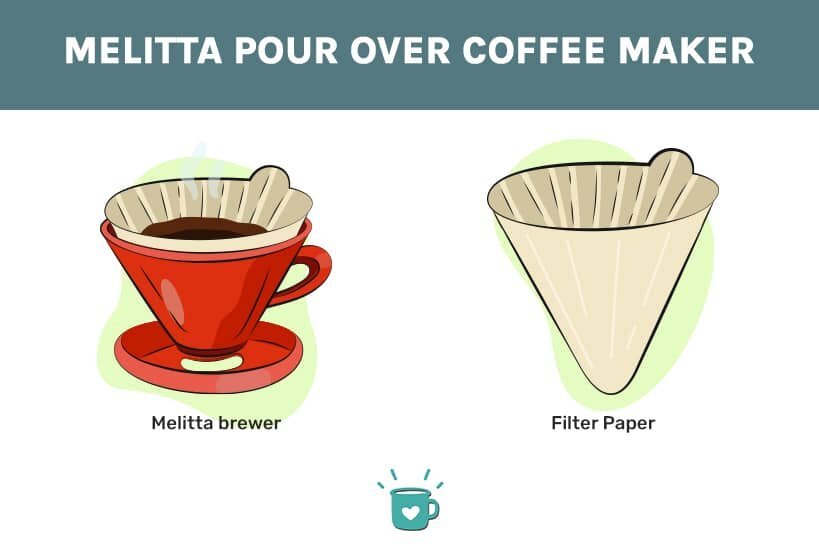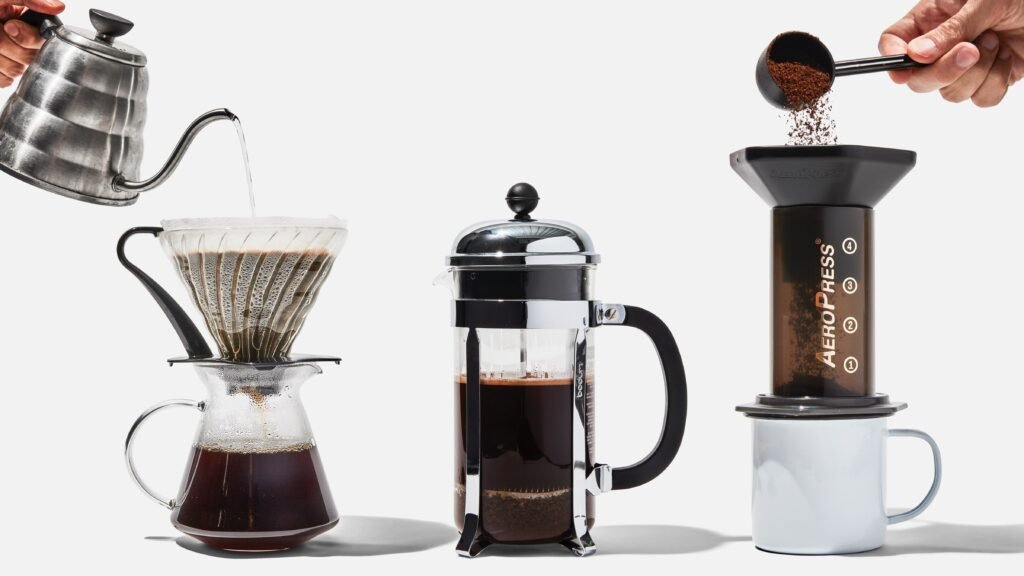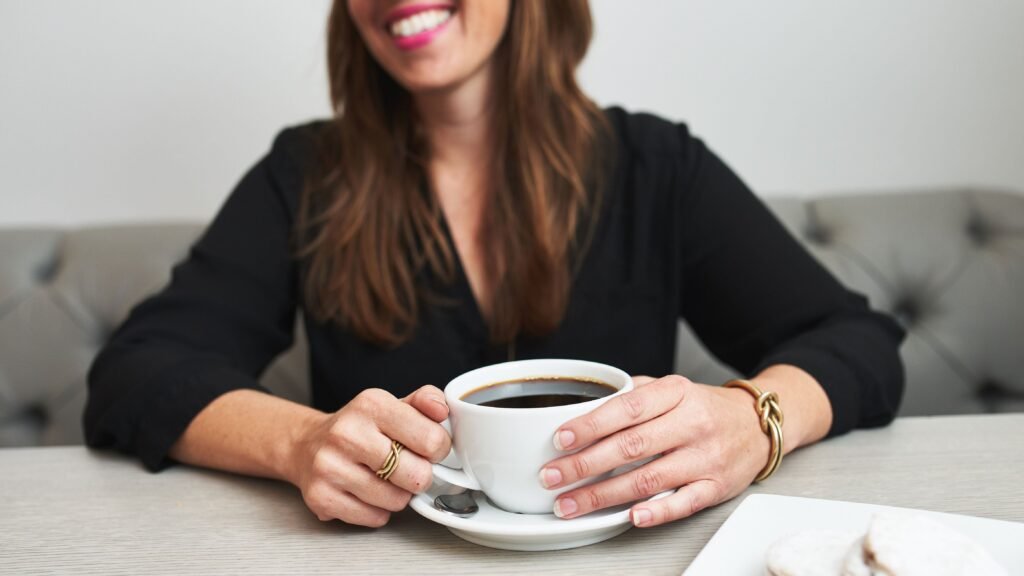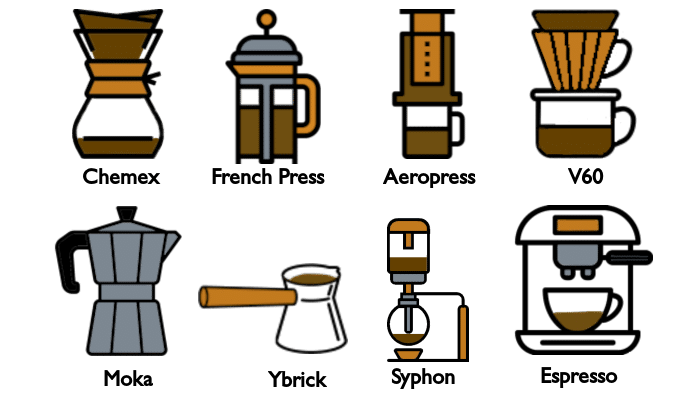If you’re ready to take your coffee brewing skills to the next level and venture into the exciting world of experimenting with different methods and techniques, then look no further. In this article, you’ll discover the top 9 tips to help you navigate through this exhilarating coffee journey. From choosing the right beans to understanding the importance of water temperature, these tips will equip you with the knowledge and confidence to brew the perfect cup of coffee every time. So grab your favorite mug, and let’s embark on this caffeine-fueled adventure together!
Choosing the Right Coffee Beans
When it comes to brewing the perfect cup of coffee, selecting the right coffee beans is essential. The flavor profile of your coffee will largely depend on the type of beans you choose. There are several factors to consider when determining the flavor profile you desire.
Determine the Flavor Profile You Desire
Before you start searching for coffee beans, take a moment to think about the flavors you enjoy. Are you a fan of bold, dark roasts with rich and intense flavors? Or do you prefer lighter roasts that have more delicate and nuanced flavors? Understanding your preferences will help you narrow down your options when it comes to choosing the right coffee beans.
Consider the Roast Level
Coffee beans are available in a range of roast levels, from light to dark. Each roast level produces different flavors and characteristics in the cup of coffee. Light roasts tend to have more acidity and brightness, with flavors that highlight the coffee bean’s natural characteristics. On the other hand, dark roasts have a fuller body and bolder flavors, often with hints of chocolate or caramel.
Buy Freshly Roasted Beans
Freshness is key when it comes to coffee beans. To ensure that you’re getting the best flavor, try to buy freshly roasted beans. Look for coffee beans that have been roasted within the past two weeks. This will help preserve the beans’ natural flavors and aromas, resulting in a more vibrant and enjoyable cup of coffee.
Select the Right Bean Variety
Coffee beans come in different varieties, each with its own unique flavor profile. Some popular varieties include Arabica, Robusta, and Liberica. Arabica beans are known for their delicate flavors and acidity, while Robusta beans have a stronger and more bitter taste. Liberica beans are less common but are prized for their unique fruity and floral flavors. Consider experimenting with different bean varieties to discover the flavors that you enjoy the most.
Understanding Grind Size
The grind size of your coffee beans plays a crucial role in the extraction process, as it determines the surface area of the coffee that comes into contact with water. Finding the right grind size for your preferred brewing method is essential for achieving the best-tasting coffee.
Matching Grind Size with Brew Method
Different brewing methods require different grind sizes to achieve optimal extraction. For example, if you’re using a pour-over method, a medium grind size is typically recommended. This allows for a balanced extraction and prevents over-extraction or under-extraction. On the other hand, for a French press method, a coarse grind size is preferred to prevent sediment from ending up in your cup. Take the time to research and understand the appropriate grind size for your chosen brewing method.
Experiment with Coarse and Fine Grinds
While there are general guidelines for grind sizes based on brewing methods, experimenting with different grind sizes can help you fine-tune the flavors of your coffee. Coarser grinds generally result in a milder cup, while finer grinds produce a stronger and more robust flavor. Don’t be afraid to try different grind sizes and adjust them to your personal preferences.
Invest in a Quality Burr Grinder
To achieve consistent and precise grind sizes, investing in a quality burr grinder is highly recommended. Unlike blade grinders, which can result in uneven grind sizes, burr grinders crush the coffee beans between two burrs, resulting in a more uniform grind. This ensures optimal extraction and allows you to have more control over the flavor of your coffee.

This image is property of fixcom-g4bhetdmcgd9b7er.z01.azurefd.net.
Optimizing Water Quality
Water is the primary ingredient in coffee, and its quality can greatly affect the taste of your brew. Paying attention to the water you use is crucial for a great cup of coffee.
Using Filtered Water
Using filtered water can significantly improve the taste of your coffee. Tap water may contain impurities and minerals that can impact the flavor. Investing in a water filter or using filtered water can help remove any unwanted elements and ensure a cleaner taste in your coffee.
Avoid Distilled Water
While filtered water is recommended, it’s important to note that distilled water should be avoided. Distilled water lacks minerals that are necessary for proper extraction, resulting in a flat and dull-tasting cup of coffee. It’s best to strike a balance by using filtered water that still retains some minerals.
Finding the Right Water Temperature
The water temperature during brewing also plays a vital role in the extraction process. The ideal water temperature for brewing coffee is between 195°F and 205°F (90°C and 96°C). Water that is too hot can lead to over-extraction, resulting in a bitter taste, while water that is too cold may not extract enough flavor from the coffee beans. Investing in a kettle with a built-in thermometer can help you achieve the perfect water temperature consistently.
Exploring Different Brewing Equipment
There are countless brewing methods and equipment options available, each offering its own unique characteristics and flavors. Exploring and experimenting with different brewing equipment can open up a whole new world of coffee flavors.
Try Pour-Over Coffee
Pour-over brewing is a popular method that allows for precision and control over the brewing process. It involves pouring hot water over coffee grounds in a filter, allowing the water to drip through into a container below. This method produces a clean and flavorful cup of coffee, highlighting the nuances of the beans.
Experiment with French Press
The French press is a classic brewing method that results in a full-bodied and rich cup of coffee. It involves steeping coffee grounds in hot water for a few minutes, then pressing a plunger to separate the brewed coffee from the grounds. French press brewing allows for a stronger extraction and can bring out different flavors compared to other methods.
Venture into Espresso Machines
Espresso machines offer the ability to brew concentrated shots of coffee with a thick layer of crema. They use highly pressurized water to extract the flavors from the coffee beans quickly. Espresso brewing requires skill and precision to achieve the perfect balance of flavors, making it a favorite method for coffee enthusiasts.
Consider Aeropress
The Aeropress is a versatile and portable brewing device that allows you to experiment with different techniques and variables. It uses air pressure to extract the flavors from the coffee grounds, resulting in a clean and concentrated cup of coffee. The Aeropress is known for its ability to produce a wide range of coffee flavors and is a popular choice among coffee enthusiasts.

This image is property of www.homegrounds.co.
Mastering the Pour-Over Technique
While pour-over brewing may seem simple, mastering the technique can take some practice. Paying attention to the details and understanding the various pouring techniques can help you achieve consistently excellent pour-over coffee.
Choosing the Right Pour-Over Device
There are several pour-over devices available, each with its own unique design and features. Some popular options include the Hario V60, Chemex, and Kalita Wave. Choosing the right pour-over device depends on your personal preferences and brewing style. Consider factors such as brew capacity, extraction control, and ease of use when selecting a device.
Understanding Pouring Techniques
The pouring technique plays a crucial role in controlling the extraction and flow rate of the water. For example, the Bloom technique involves pouring a small amount of water over the coffee grounds to release trapped gases, allowing for better extraction. The Spiral technique involves pouring in a circular motion, starting from the center and gradually moving outward. Experimenting with different pouring techniques can help you fine-tune the flavor of your pour-over coffee.
Practicing Proper Water-to-Coffee Ratio
The water-to-coffee ratio is a critical aspect of pour-over brewing. It determines the strength and flavor of your coffee. A common ratio is 1:16, which means 1 part coffee to 16 parts water. However, the ratio can be adjusted based on personal preference. Experimenting with different ratios can help you find the perfect balance and achieve the desired flavor in your cup of coffee.
Perfecting the French Press Method
The French press method is loved by many for its simplicity and ability to produce a rich and full-bodied cup of coffee. To perfect this brewing method, attention should be given to the coarseness level, steep time, and water-to-coffee ratio.
Finding the Right Coarseness Level
In French press brewing, a coarse grind size is recommended to prevent fine particles from seeping through the metal mesh filter. The coarse grind allows for a slower extraction and produces a cleaner cup without sediment. Adjusting the coarseness level can influence the strength and flavor of your coffee, so don’t hesitate to experiment.
Mastering the Steep Time
The steep time is another crucial factor in French press brewing. Typically, a steep time of four to five minutes is recommended. Steeping for too short a time may result in under-extraction, producing a weak and watery cup of coffee. Steeping for too long can lead to over-extraction and a bitter taste. Monitoring and adjusting the steep time can help you achieve the desired flavor and strength.
Using the Correct Water-to-Coffee Ratio
The water-to-coffee ratio for French press brewing is typically 1:15 or 1:17, depending on personal preference. A higher ratio will result in a stronger and more intense cup, while a lower ratio will yield a milder flavor. Finding the right balance and adjusting the ratio to your taste preferences is key to perfecting your French press coffee.

This image is property of assets.bonappetit.com.
Delving into Espresso Brewing
Espresso brewing is an art form that requires precision and attention to detail. From investing in a quality espresso machine to mastering the texture of milk for milk-based espresso drinks, there are several factors to consider when delving into this brewing method.
Investing in a Quality Espresso Machine
A good espresso machine is essential for producing consistent and high-quality shots of espresso. Look for a machine that offers precise temperature and pressure control, as well as a reliable extraction mechanism. Investing in a quality espresso machine will provide you with the tools necessary to achieve excellent results.
Understanding the Importance of Freshly Ground Beans
Freshly ground beans are crucial in espresso brewing. The grind size should be fine and uniform to ensure proper extraction. Aim to grind your beans just before brewing to retain the flavors and aromas. With espresso brewing, the extraction process is quick, and using fresh grounds will result in a more flavorful and balanced shot.
Controlling Variables like Pressure and Brew Time
Controlling the variables of pressure and brew time is essential for achieving the perfect shot of espresso. The ideal brew time is typically around 25 to 30 seconds. Too short a brew time will result in an under-extracted shot, while too long will lead to over-extraction and a bitter taste. Understanding and adjusting these variables based on the specific coffee beans and personal preferences is a crucial step in mastering espresso brewing.
Texturing Milk for Milk-Based Espresso Drinks
If you enjoy milk-based espresso drinks like lattes and cappuccinos, mastering the art of milk texturing is key. Achieving silky, velvety milk with the perfect amount of foam can enhance the overall experience of your espresso beverages. Experiment with different milk textures and techniques to create latte art and enhance the flavor profiles of your drinks.
Experimenting with Cold Brew
Cold brew has gained popularity in recent years, offering a unique and refreshing alternative to traditional hot coffee. Understanding the brewing process, optimizing the steeping time, and trying different coffee-to-water ratios can help you experiment and create your perfect cold brew.
Understanding the Brewing Process
Cold brew involves steeping coffee grounds in cold or room temperature water for an extended period, typically 12 to 24 hours. This slow extraction process results in a smooth and less acidic cup of coffee. Understanding the basics of cold brew brewing, such as the grind size and water-to-coffee ratio, is essential for achieving the desired flavors.
Optimizing the Steeping Time
The steeping time for cold brew can vary depending on personal preference and the desired strength of the coffee. Experimenting with different steeping times, ranging from 12 to 24 hours, can help you find the sweet spot that produces the flavors you enjoy. Keep in mind that longer steeping times generally result in a stronger and more concentrated brew.
Trying Different Coffee-to-Water Ratios
The coffee-to-water ratio in cold brew brewing can vary depending on the desired strength and flavor. A common ratio is 1:4, which means 1 part coffee to 4 parts water. However, you can adjust this ratio to your taste preferences. Trying different ratios can help you find the perfect balance and create a cold brew that suits your preferences.

This image is property of www.caffeluxxe.com.
Understanding Brew Ratios
Mastering brew ratios allows you to have more control over the strength and flavor of your coffee. Understanding the ideal coffee-to-water ratio, adjusting ratios for personal preference, and distinguishing between strength and extraction are all crucial in achieving the perfect cup of coffee.
Finding the Ideal Coffee-to-Water Ratio
The ideal coffee-to-water ratio will vary depending on the brewing method and personal taste preferences. As a general guideline, a coffee-to-water ratio of 1:15 to 1:18 is commonly used in drip brewing. For espresso, a ratio of 1:2 is often recommended. However, feel free to adjust these ratios to your liking and experiment to find the perfect balance for your taste buds.
Adjusting Ratios for Personal Preference
Experimenting with different coffee-to-water ratios is crucial for finding the strength and flavor profile that you enjoy. Increasing the coffee-to-water ratio will result in a stronger and bolder cup, while decreasing the ratio will produce a milder flavor. Pay attention to the balance between coffee and water to achieve the desired taste in your cup.
Understanding Strength vs. Extraction
When talking about brew ratios, it’s important to distinguish between strength and extraction. Strength refers to the intensity of the coffee’s flavor, while extraction represents the percentage of soluble compounds that have been extracted from the coffee grounds. Adjusting the coffee-to-water ratio can affect both strength and extraction. By understanding the relationship between the two, you can fine-tune your brewing process to achieve the perfect balance.
Documenting Your Brew Methods
Keeping track of your brew methods and experimentation results can be immensely helpful in your coffee journey. A brew journal allows you to record variables such as time, grind size, and water temperature, as well as track flavor profiles and the results of your experiments.
Keeping a Brew Journal
A brew journal provides a space for you to document your brewing techniques, observations, and discoveries. You can include details such as the coffee beans used, the brewing method, and any adjustments made. This record will help you replicate successful brews and identify any areas for improvement.
Recording Variables like Time and Grind Size
To create consistent and repeatable brews, it’s important to record variables such as brew time and grind size. These factors directly impact the flavor and characteristics of your coffee. By keeping track of the specific details for each brew, you can make informed adjustments in the future.
Tracking Flavor Profiles and Experimentation Results
One of the most enjoyable aspects of exploring different brewing methods is discovering new flavor profiles. Tracking these flavor profiles in your brew journal can help you uncover your personal preferences and identify specific characteristics you enjoy. Additionally, recording the results of your experiments will allow you to see patterns and trends over time, giving you insights into your brewing skills and helping you refine your techniques.
By following these tips and experimenting with various coffee brew methods and techniques, you can embark on a journey of discovery and create the perfect cup of coffee tailored to your taste preferences. Remember to have fun and enjoy the process as you explore the vast world of coffee brewing. Cheers to your coffee adventures!

This image is property of eadn-wc03-5074352.nxedge.io.


